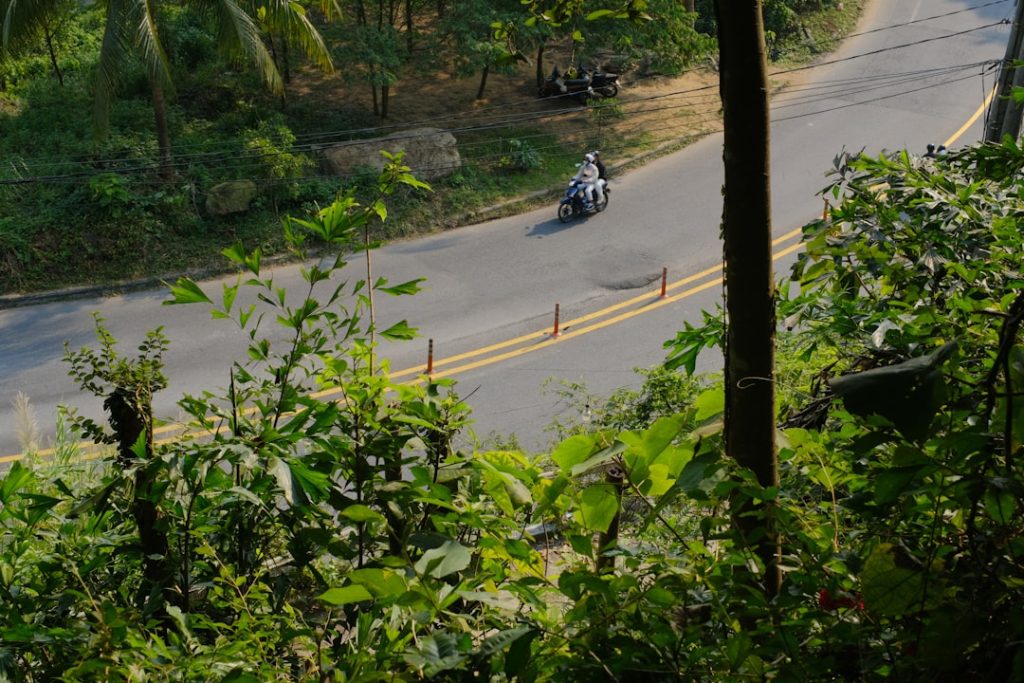Finding the Right Affordable Motorcycle for Your Budget
The cheapest motorcycle you can buy new from a major brand in America is the Honda Navi at $1,999. However, several excellent options under $5,000 offer even better value and reliability.
Quick Answer: Top Cheapest Motorcycles by Category
| Category | Model | Price | Best For |
|---|---|---|---|
| Absolute Cheapest | Honda Navi | $1,999 | Urban commuting, beginners |
| Best Value Cruiser | Royal Enfield Classic 350 | $4,699 | Classic styling, reliability |
| Budget Sportbike | KTM 250 Duke | $4,599 | Performance on a budget |
| Entry Sport | Kawasaki Ninja 500 | $5,299 | New sport riders |
| Off-Road | Honda XR150L | $3,099 | Trail riding, farm use |
Important Warning: While you can find motorcycles for under $1,000 on sites like Amazon (X-PRO, Boom brands), these ultra-cheap bikes often require extensive repairs, have poor safety records, and lack dealer support. They are project bikes at best, not reliable transportation.
Riding a motorcycle doesn’t have to drain your bank account. Manufacturers like Honda, Royal Enfield, and Kawasaki now offer quality bikes in the $2,000-$7,000 range. These affordable motorcycles typically feature smaller engines (125cc-500cc) and simpler technology, but they’re still real motorcycles from brands that stand behind their products.
The key is understanding what “cheap” really means. A $1,000 bike might seem like a bargain, but when you factor in immediate repairs and safety concerns, it’s rarely worth it. Spending just a bit more gets you a reliable machine with a warranty, available parts, and dealer support.
I’m D.J. Hearsey, founder of Select Insurance Group. With three decades in the insurance industry, I’ve helped countless riders find coverage for their first cheapest motorcycle. This guide cuts through the noise to show you the best affordable motorcycles that will actually get you riding.
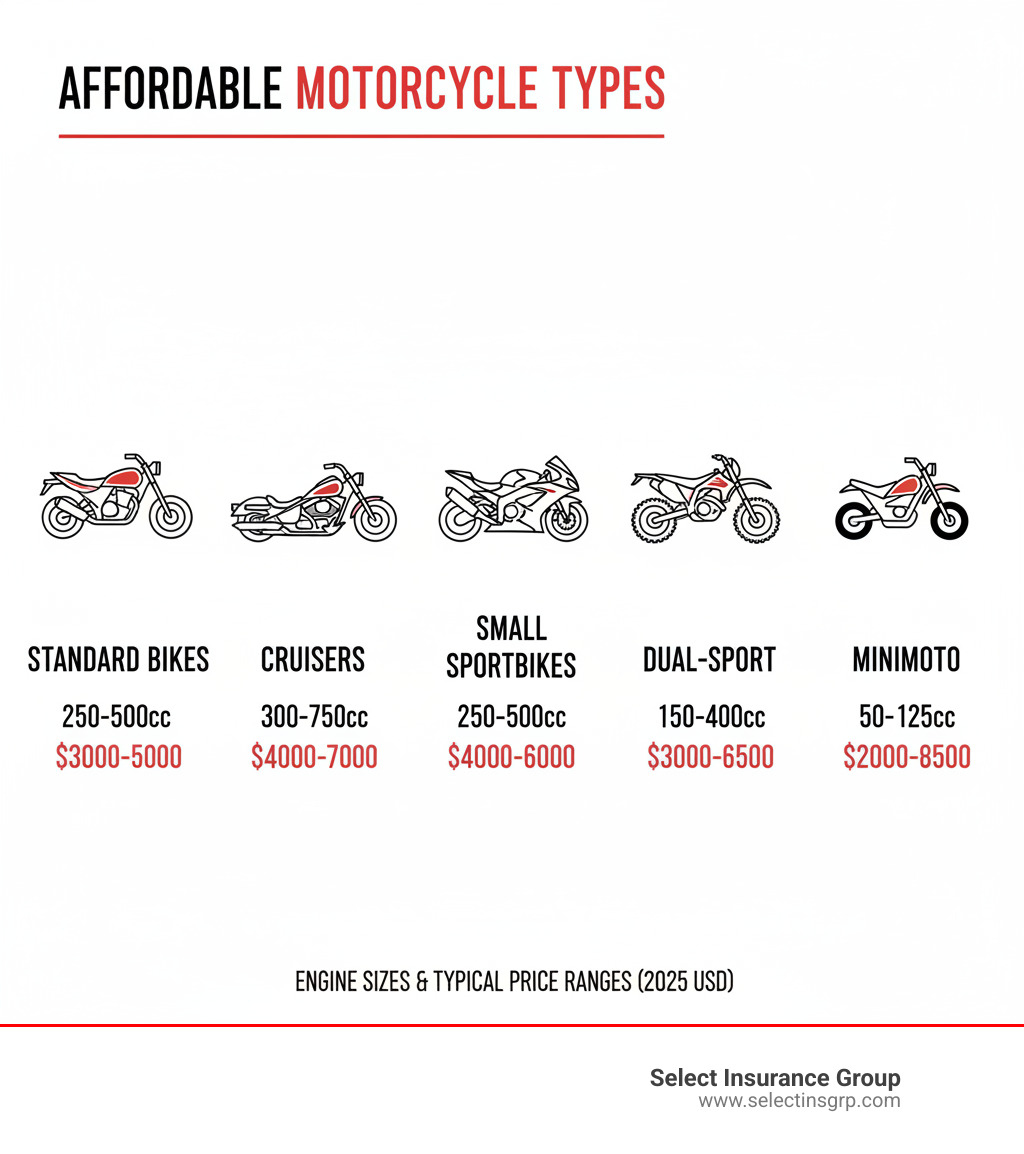
Understanding the Budget Motorcycle Market
When people shop for the cheapest motorcycle, they often focus only on the initial price. Smart riders, however, consider the bigger picture: reliability, long-term costs, and overall enjoyment.
Today’s affordable bikes are thoughtfully designed machines that prioritize getting you on the road safely. They typically feature smaller displacement engines (125cc-500cc), making them light, fuel-efficient, and easy to handle for beginners. They also use simpler technology, skipping expensive electronic aids to keep costs down and maintenance straightforward. The sweet spot for a new, reputable, and affordable motorcycle is between $2,000 and $7,000.
What Makes a Motorcycle Affordable?
Several factors contribute to a motorcycle’s lower price tag:
- Engine Size: Smaller engines (under 500cc) require fewer materials and simpler manufacturing.
- Manufacturing Location: Production in countries with lower labor costs allows brands to offer competitive pricing.
- Technology: Budget bikes often use steel frames instead of aluminum and may have simpler systems like carburetors instead of electronic fuel injection (EFI) on some models.
- Amenities: A lack of features like large fairings, advanced digital displays, and traction control keeps the final cost down.
Common Types of Budget-Friendly Bikes
There’s an affordable motorcycle for every riding style.
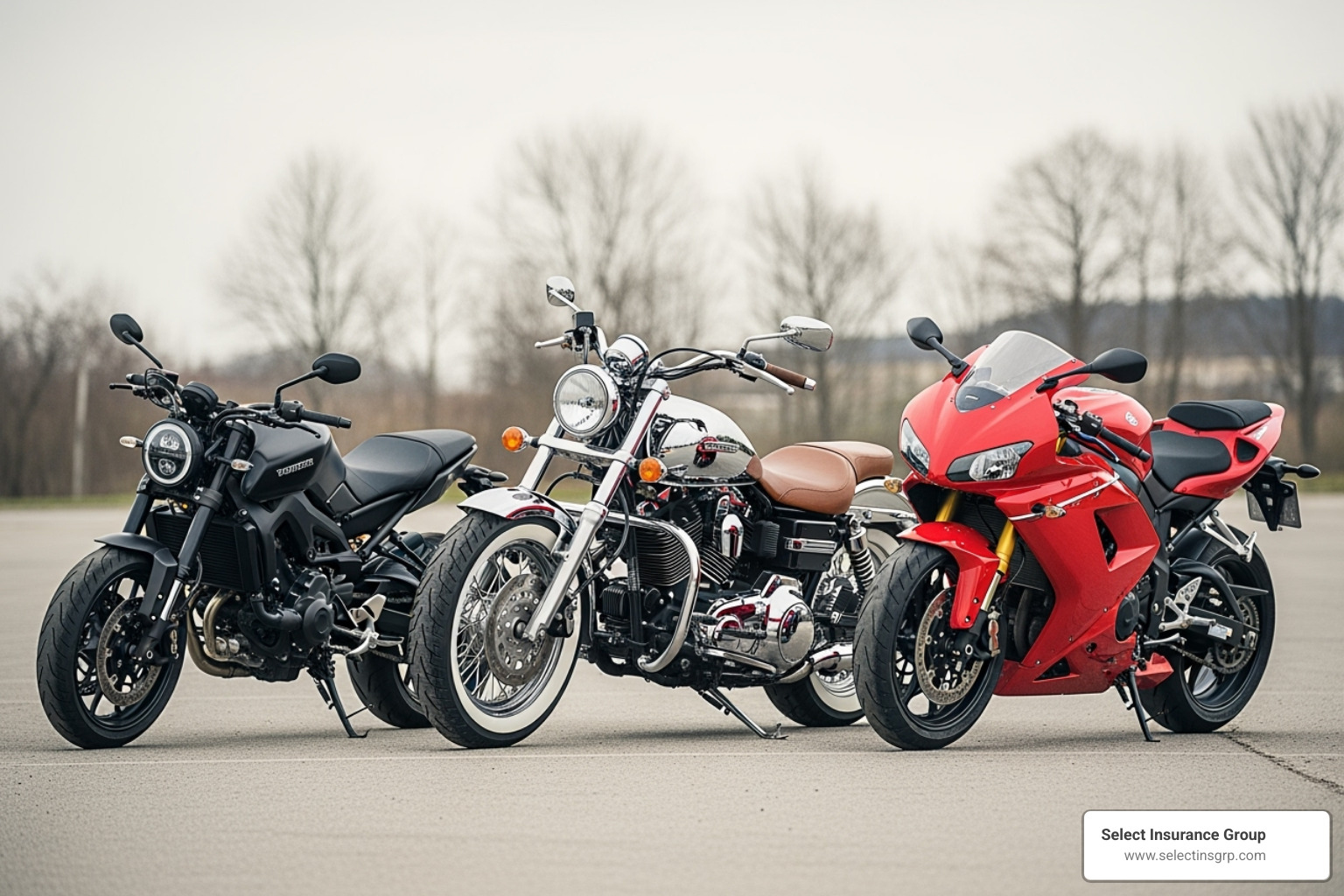
- Standard/Naked Bikes: These are versatile workhorses with comfortable, upright riding positions and minimal bodywork, making them great for commuting and weekend rides.
- Cruisers: Smaller-engine cruisers like the Honda Rebel 300 or Royal Enfield Classic 350 offer classic styling and a relaxed ride without a premium price.
- Small-Displacement Sportbikes: Models like the Kawasaki Ninja 500 provide sporty looks and agile handling for riders who want excitement without extreme power.
- Dual-Sport Motorcycles: The Swiss Army knives of the motorcycle world, bikes like the Honda XR150L can handle both paved roads and dirt trails.
- MiniMOTOs: Compact and fun, bikes like the Honda Navi are perfect for zipping around town and offer an easy entry point into motorcycling.
Top Affordable New Motorcycles from Reputable Brands
Finding the right cheapest motorcycle is about value—a bike that gets you on the road without constant headaches. That means choosing a reputable brand with a warranty, a dealer network, and a product that holds its value.
Here are the new, affordable motorcycles from brands we trust, delivering genuine enjoyment without the worry of questionable quality.
The Ultimate Commuter: Honda Navi
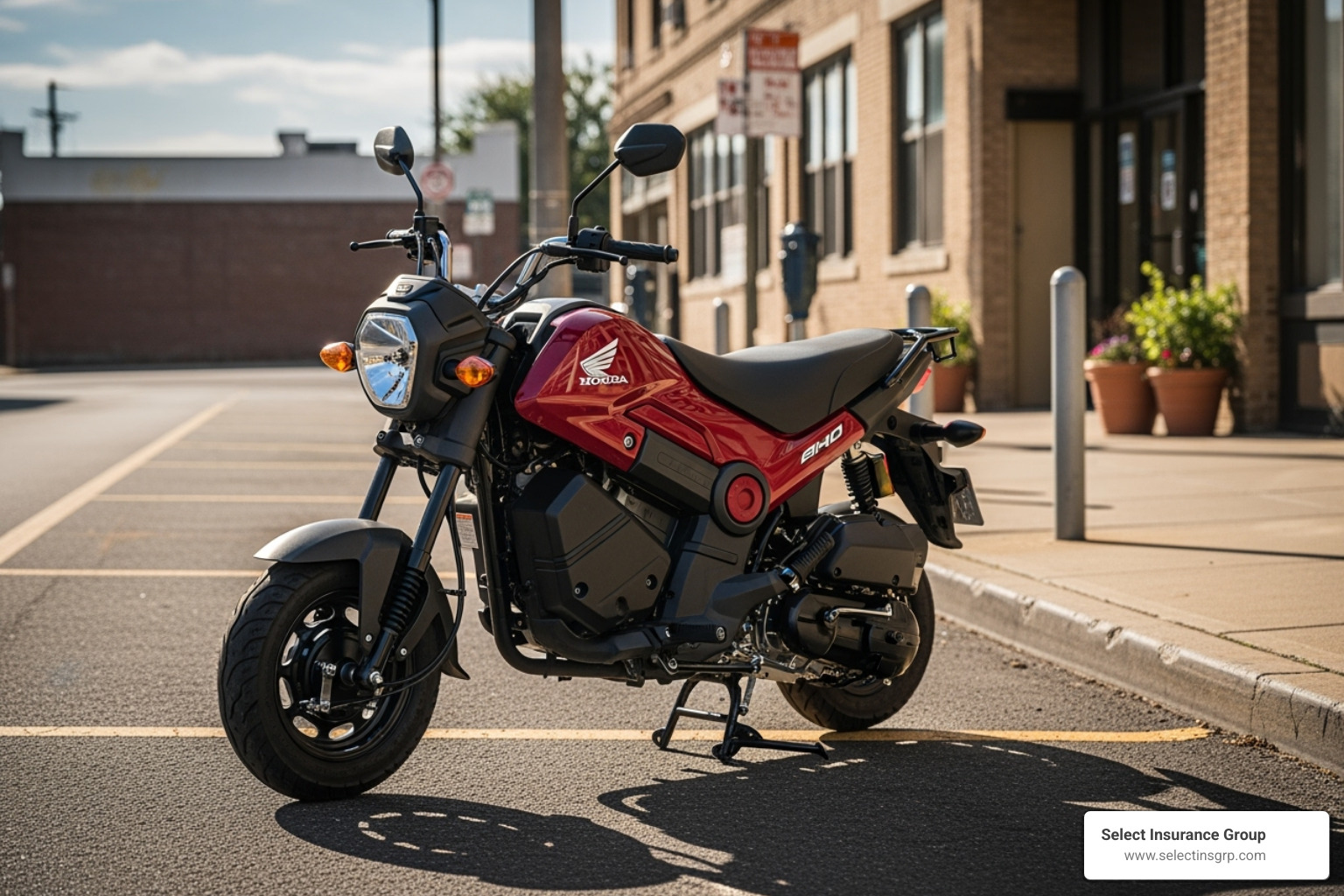
At just $1,999 MSRP, the Honda Navi is America’s most affordable gateway motorcycle. Its 109cc engine and CVT automatic transmission (no clutch, no shifting) make it incredibly beginner-friendly. The low seat height and light weight add to its accessibility. While not a highway bike, it’s perfect for zipping through city streets, getting over 100 mpg, and having fun on a budget. With Honda’s legendary reliability, the Navi delivers more smiles per dollar than bikes costing twice as much. See more at the little Honda Navi page.
The Classic Cruiser: Royal Enfield Classic 350

The Royal Enfield Classic 350 captures timeless cruiser style for just $4,699. With design cues from the 1950s, it offers genuine retro appeal. The 349cc single-cylinder engine provides smooth, manageable power perfect for new and experienced riders alike. What truly sets it apart is the 3-year unlimited mile warranty with roadside assistance—a level of support rarely seen at this price. This bike is a beacon of affordability in classic motorcycles, letting you live the vintage dream without the vintage problems.
The Naked Sportster: KTM 250 Duke
For aggressive styling and performance on a budget, the KTM 250 Duke delivers at $4,599. KTM poured its “Ready to Race” DNA into this affordable naked sportster. The new 250cc engine sits in a lightweight trellis frame, and the bike features sharp bodywork, LED lighting, and a digital display. It’s nimble, responsive, and fun, whether in city traffic or on twisty roads. KTM focused on what matters: quality suspension, strong brakes, and modern features, making it feel like a more expensive machine. Learn more about an affordable motorcycle with a brand-new 250 cc engine.
The Entry-Level Sportbike: Kawasaki Ninja 500
The Kawasaki Ninja 500 brings the brand’s legendary sportbike heritage to new riders for $5,299. Kawasaki updated the previous Ninja 400 with a larger 451cc parallel-twin engine and new styling while keeping the price the same. The power is approachable yet exciting, allowing you to grow your skills. The aesthetics are pure Ninja, looking like bikes that cost thousands more. We always recommend the ABS version for its added safety margin. The Ninja 500 is Kawasaki’s answer for getting into sportbikes without breaking the bank, offering more power and an updated aesthetic at a great price.
The Absolute Cheapest Motorcycle: A Buyer’s Guide to Ultra-Budget Bikes
Let’s discuss the absolute cheapest motorcycle options—those under $1,500 from lesser-known brands like X-PRO and Boom, often found on Amazon. These “dropship” bikes are typically clones of older Japanese designs, produced in various Chinese factories.
While the retro styling can be charming, we must issue a serious buyer beware warning. These are not recommended for anyone seeking reliable transportation. As one expert put it, they are “glorious garbage.” The low price comes with significant trade-offs.
What to Expect from the Cheapest Motorcycle
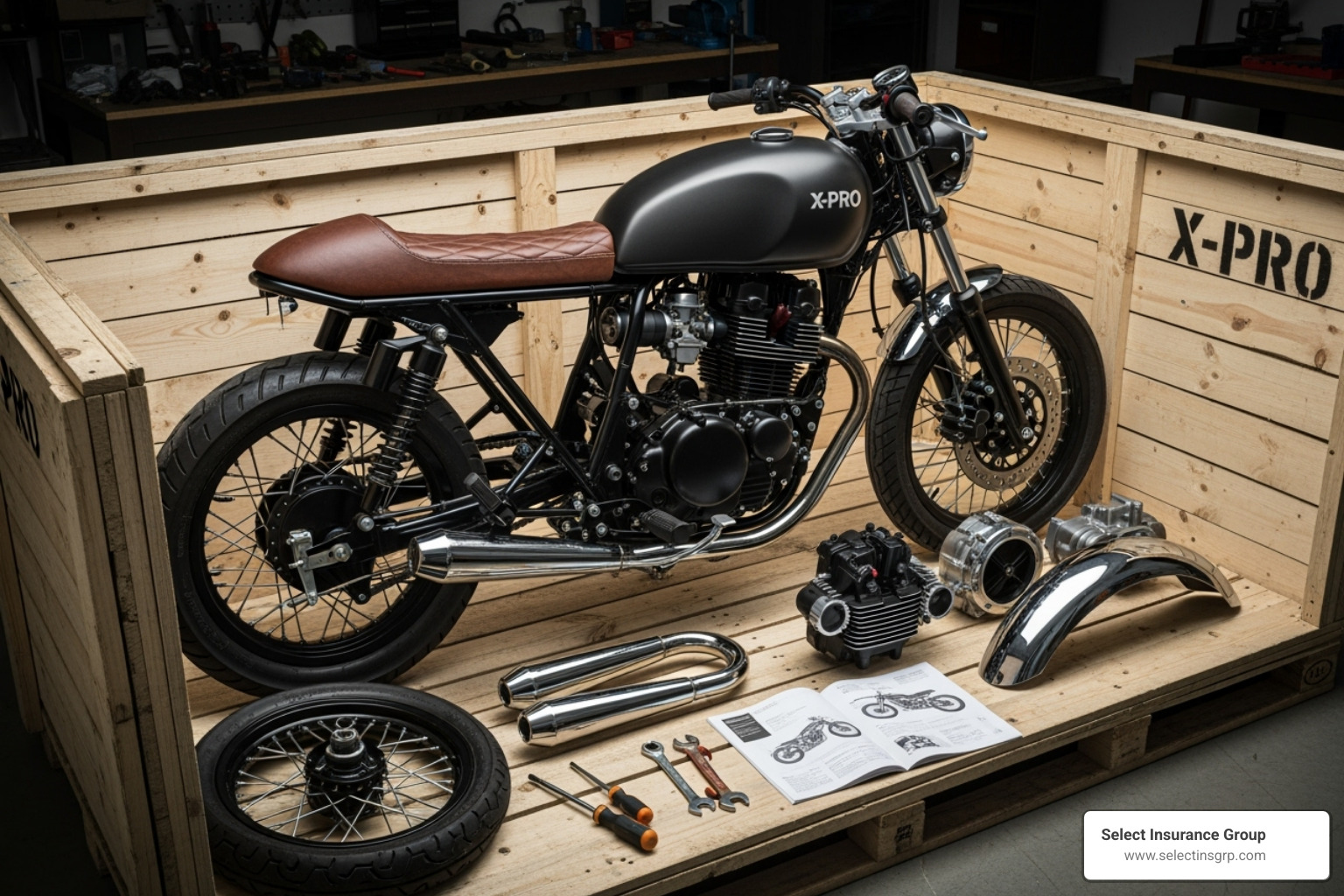
Ordering an ultra-cheap motorcycle means it arrives in a crate, partially disassembled. You must assemble it yourself. Expect the following:
- Poor Build Quality: Corners are cut everywhere. Bolts are loose, electrical connections are exposed, and parts can be so fragile they break during assembly.
- Safety Concerns: These bikes often use outdated technology like drum brakes. The tires are low-quality, and the wiring is unreliable. Some owners report warped frames right out of the box.
- No Dealer Support: There is no warranty or service network. Finding replacement parts is a difficult hunt through obscure websites.
The X-Pro MC-N025, found for around $800 on Amazon, is marketed as A cute $1,000 retro bike you probably shouldn’t buy. Reviews mention violent shaking, immediate carburetor replacements, and unpredictable performance. These are project bikes for enthusiasts who enjoy wrenching more than riding. If you want reliable transportation, stay far away.
Hidden Costs and Immediate Repairs
The sticker price is just the start. A $1,000 bike can quickly cost much more. You’ll face shipping fees (around $400), assembly costs, and the expense of immediate, necessary upgrades to make it safe. This includes new tires, fluids, fasteners, and sealing electrical connections. One person notes common issues like wiring problems and even warped swingarms.
Let’s compare the true first-year cost:
| Item | Reputable Brand (Honda Navi) | Ultra-Budget Brand (X-PRO) |
|---|---|---|
| MSRP | $1,999 | $1,000 |
| Shipping/Destination | $300 | $400 |
| Assembly | N/A (dealer assembled) | $200 (DIY effort/tools) |
| Immediate Upgrades/Repairs | Minimal/None | $500 (tires, wiring, fasteners, fluids, bearings) |
| Total True First-Year Cost | $2,299 | $2,100 |
As you can see, the cheapest motorcycle ends up costing nearly the same as a reliable Honda Navi—but with none of the peace of mind, warranty, or dealer support. That $1,000 price tag is an illusion.
Essential Ownership Costs Beyond the Sticker Price
When shopping for the cheapest motorcycle, the purchase price is just the beginning. The total cost of ownership includes regular maintenance, safety gear, insurance, and potential repairs. Understanding these costs upfront is crucial to ensure you can afford to ride the bike you buy.
Maintenance, Gear, and Insurance
Every motorcycle requires routine maintenance like oil changes, chain adjustments, and brake and tire replacements. With a reputable brand like Honda or Kawasaki, parts are readily available and repairs are straightforward. With an ultra-cheap bike, owners report spending more time fixing their bikes than riding them, and finding parts can be a nightmare.
Before your first ride, you must invest in proper safety gear. A DOT-approved helmet, riding jacket, gloves, and boots are non-negotiable. We also strongly encourage all riders to take a motorcycle safety course. These courses from organizations like the MSF teach life-saving skills and may even earn you an insurance discount.
Finally, insurance premiums are a mandatory cost. You’ll need at least liability coverage, but comprehensive and collision coverage offer greater protection. Insurance costs depend on your age, riding record, location, and the motorcycle itself. A smaller bike like the Honda Navi will be significantly cheaper to insure than a large sportbike.
At Select Insurance Group, we help riders find the right coverage for their budget. We shop over 40 carriers to get you competitive rates. Insurance requirements vary by state, and we offer detailed guides for riders in our service areas:
- Virginia Motorcycle Insurance
- South Carolina Motorcycle Insurance
- North Carolina Motorcycle Insurance
- Georgia Motorcycle Insurance
- Florida Motorcycle Insurance
Factoring in these ongoing costs—gear, insurance, and maintenance—gives you a realistic picture of what it takes to own a motorcycle.
Frequently Asked Questions about Affordable Motorcycles
When helping riders find their first cheapest motorcycle, we hear the same smart questions. Here are the answers to the most common concerns.
Is it better to buy a cheap new motorcycle or a used one?
This depends on your priorities. A new bike offers a factory warranty, a known history, and modern features like ABS. A used bike can offer more power or features for the same money, as the first owner absorbed the initial depreciation. A well-maintained used bike from a major brand like Honda or Yamaha is almost always a smarter investment than a new, ultra-cheap motorcycle from an unknown brand. The key with a used bike is to have it thoroughly inspected by a trusted mechanic before you buy.
What are the biggest risks of buying the absolute cheapest motorcycle available?
The risks are significant and can affect your safety and finances:
- Safety Risks: Poor build quality can lead to brake failures, tire blowouts, or electrical system failures mid-ride.
- Reliability Issues: These bikes require constant repairs, meaning more time wrenching than riding.
- No Support: A lack of dealer support and available parts can make repairs impossible, leaving you with a non-functional bike.
- Registration Problems: Incomplete or incorrect paperwork can make it a nightmare to legally title and register the bike.
- Zero Resale Value: These bikes depreciate rapidly and are extremely difficult to sell.
For these reasons, we recommend these bikes only for experienced mechanics who enjoy a project.
How much does insurance cost for a cheap motorcycle?
Good news: smaller, less expensive motorcycles are typically cheaper to insure. Your exact rate will depend on your age, riding experience, driving record, and location. The bike’s type and engine size also play a major role—a 250cc standard bike will cost less to insure than a 600cc sportbike. You can also get discounts for completing an MSF course or bundling policies.
For example, an average full coverage policy in South Carolina might be around $30 per month, while liability-only could be as low as $16 per month. Your rates will vary. At Select Insurance Group, we help you steer these factors to find the best rate. For more details, explore our resources on Georgia Motorcycle Insurance and Florida Motorcycle Insurance.
Conclusion
Starting your motorcycle journey doesn’t require a huge budget. As we’ve seen, the market offers reliable, affordable options from reputable brands like Honda, Royal Enfield, and Kawasaki that provide real value and peace of mind.
The most important lesson is to balance price and quality. While ultra-cheap, sub-$1,500 bikes are tempting, they often become money pits due to hidden costs and constant repairs. Our advice is to invest in a cheapest motorcycle from a known manufacturer. That extra investment buys you a warranty, dealer support, and a bike that runs reliably.
For new riders, safety is the first priority. Invest in quality riding gear and sign up for a motorcycle safety course through the MSF’s site. The skills you learn are invaluable.
The joy of riding is accessible to almost everyone. With smart shopping and realistic expectations, you can find a motorcycle that fits your budget and your dreams. You don’t need the most expensive bike to experience the freedom of two wheels.
At Select Insurance Group, we’ve spent over 30 years helping riders protect their bikes. Finding the right motorcycle is half the journey—protecting it with the right insurance is just as crucial. Our team shops over 40 carriers to find you competitive rates.
Ready to take the next step? Get a Quote on our website in just a few minutes. Whether you’re in Virginia, the Carolinas, Georgia, or Florida, we’re here to help. Find the right motorcycle insurance in Virginia for your new ride and get ready to enjoy the open road.

